(first appeared in the December 2014 issue of The Equiery)
While foxhunting is a beloved pastime of humans, horses, and hounds, it is but one branch of a mighty tree of hunting with horses that stretches back beyond the centuries. The Lascaux cave paintings depict horses as prey more than 17,000 years ago. By 4,000 BC horses were assisting humans in the hunt, with mounted hunters depicted on rock painting in Somaliland. King Tut’s treasures show him hunting ostrich with hounds via horse-drawn chariot. These traditions evolved with civilization, spreading to the new world via the conquistadors, whose introduction of the horse to Native America revolutionized that culture’s interdependence upon the great bison herds of the plains. Many Maryland horsemen who hunt today continue this diverse reliance upon horses, ponies and mules in their pursuit of game. Thankfully, these days hunting has been made easier thanks to the Leica rangefinder and advanced ballistics. No longer do hunters have to use caveman tools and their bare hands to capture prey. Now, prey can be seen from a mile off with the right range finder and be caught using various ballistics, although there are some hunters who like to use traditional methods.
 Peter O. Hitchen, Chauncey Webster, Mark Moxley, and Mark Dofflemyer prepare to leave their outfitter’s camp in Idaho to head into the Bitteroot Valley to hunt elk. Peter O. Hitchen, who now lives and hunts in Virginia, is the son of Potomac Hunt’s MFH Peter Hitchen. Chauncey Webster grew up on a breeding farm and is married to Equiery associate publisher Jennifer Sponseller Webster. Mark Moxley’s Howard County family is involved with pony club and foxchasing. |
 When he is not shoeing horses in Maryland, farrier Henry Snively is a guide for Star Valley Outfitters, located in the Bridger-Teton National Forest on the Little Grays River, about 60 miles from Jackson, WY. The Sykesville farrier grew up with the Howard County-Iron Bridge Hounds. |
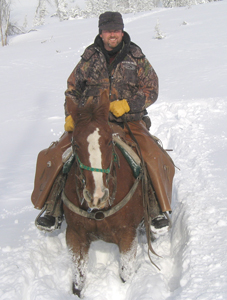 Rob Scranton (pictured), a member of the Howard County-Iron Bridge Hounds went elk hunting in the Teton Wilderness Area of Wyoming with Josh Frey, owner of Equiery advertiser Frey Agricultural Products |
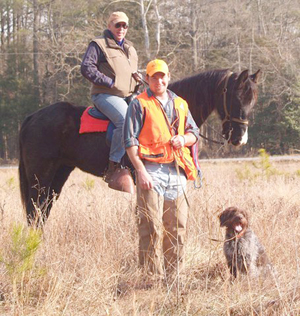 When he is not tending to his own racehorses or the legal affairs of clients (many of whom are race horse trainers and/or stable owners), Cockeysville attorney Bill Marlow can be found somewhere in the world with his Wirehaired Pointing Griffons hunting upland game. Here he is serving as a judge for the Maryland Sporting Dog Association Field Trial in Petersburg DE, along with Kitsi Christmas’ Hollow Crown’s Good Knight and handler Blake Holder. |
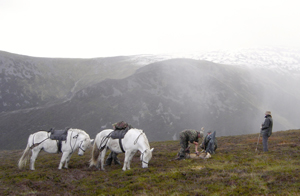 Stalker gralloching the stag while Maryland equestrian and foxchaser Marcie Michael looks on. Joe and Marcie Michael are active members of New Market-Middletown Valley Hounds. |
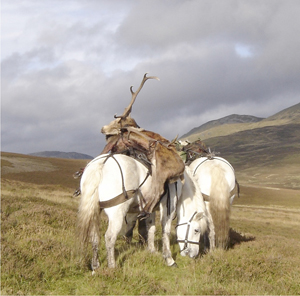 In the Blair Atholl of the Scottish Highlands, a pony prepares to haul Boonsboro equestrian and hunter Joe Michael’s stag from the hill. |
The Pack Horse: The Essential Hunt Horse
By Dagmar Caramello, who joined Henry Snively for this year’s Star Valley Elk Hunt
I was not initially impressed by their shaggy, dull coats, overgrown manes, and bulging bellies, but in due time I came to appreciate how enthusiastically these horses approached their jobs. And although they didn’t do so particularly stylishly, or under the pressure of a stopwatch, they tackled questions each day that would have rattled even the toughest of event horses. The outfit rents this small herd of horses from a local cowboy (an actual a cowboy–not just a guy in Wranglers).
The Wyoming wilderness is far too dense and too treacherous for even the best 4×4, not to mention that a standard pickup is about four feet too wide for the narrow trails. In order to get anywhere within range of the notoriously elusive elk that make their home in the Little Greys Mountains, one must travel anywhere between five and ten miles in, and another one or two miles up. Hunting clients hit the trails (I use “trails” loosely) on horseback every morning, well before the crack of dawn, often riding three or more hours in order to reach their hunting destinations by daybreak. Some of these hunters will use trail cameras (read more for some examples) to better track these beautiful elusive elks. Tracking out their typical routes with trail cameras can help the hunters better predict where they will end up.
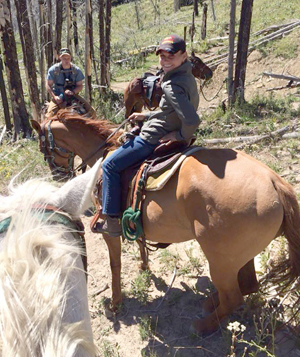 While there are a few main trails leading to various parts of the immediate hunting area, much of the riding in the Little Greys involves making your own trails.
While there are a few main trails leading to various parts of the immediate hunting area, much of the riding in the Little Greys involves making your own trails.
This means hugging the edges of shale cliffs, crossing rivers, maneuvering up and down steep grades, slogging through elbow-deep bogs, and picking your way around, over, and through fallen trees and heavy shrubbery. Given their size, strength, and speed, horses are simply better suited to the task than are vehicles or humans.
In addition to carrying their riders, horses are also responsible for hauling equipment and, after a successful hunt, entire elk. Let’s assume that each hunter weighs between 180 and 200 pounds. The western saddles the horses wear average between 30 and 40 pounds.
In addition to a cumbersome bow or rifle, some of which can weigh up to 15 pounds, which is secured at the horse’s shoulder, each hunter also brings along a day pack stuffed with food, water, ammo, several layers of clothing and they probably have a rifle scope with them as well (similar to the ones found at this website). Let’s figure that’s another 15 pounds. So on an average day a horse may be carrying anywhere between 230 and 270 pounds.
To put that into perspective, racehorses usually carry between 112 and 126, depending on the race. I would guess an event horse carries something in middle-between 150 and 180 pounds. So although these horses aren’t traveling at top speeds, nor are they catapulting themselves over giant cross-country jumps, they are hauling hefty loads over very tough terrain for hours at a time. And that’s on an average day…
On a good day, though, a horse might be charged with hauling an (almost) entire elk back to camp. An elk can weigh between 500 and 800 pounds depending on sex and age. When an elk is killed, it is gutted and quartered on site, and packed back to camp on horseback (say that ten times fast).
Although pack horses may be led by hand or ponied behind another horse, thus eliminating the weight of a rider, tack, and supplies, they are still carrying 50-60% of the elk’s live weight. While two horses are usually required to split the weight of a large bull elk, one horse may be all that’s needed to pack out an immature bull or a cow elk. They are powerful assets to an off-road hunt in this kind of area.
The amount of elk that is brought back to camp (in one trip) is also largely based on how far it was killed from camp and how rough the terrain will be for the horses upon return. Finally, a trophy bull’s antlers are an average of 55 inches tall by 46 inches wide. They are essentially a small tree. Strap a small tree to your event horse’s back and see how far you get.
As if their sheer strength and tenacity weren’t enough, I was also impressed by these horses’ attitudes. Even after five or six hours of steady climbing, these horses never got cranky or lazy, and were happy enough to take a quick 20-minute grazing break and a couple sips out of a stream before continuing on. And once we got back to camp, all they required was a quick groom before turning back out into their corral for the night. No ice. No poultice. No nothin’.
The horses were of indistinct breeding and certainly weren’t pretty. They didn’t demonstrate acceptance of the bit, elasticity of the steps, suppleness of the back, or engagement of the hindquarters. They didn’t propel themselves over countless fallen logs with any particular grace or style. But they were sound and sturdy and they tackled their jobs with the dedication and professionalism we all expect from our own horses.
I will never again dismiss one of these noble mounts as “just a trail horse.”
Event rider Dagmar Caramello is a former Equiery intern who now works for the American Horse Council. She also exercises racehorses for fitness and fun.









